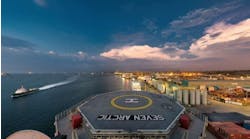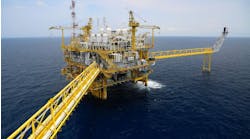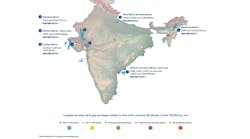Judy Maksoud
International Editor
Offshore
Reducing the time between a deepwater field discovery and first production saves money, according to Dr. Beverly Ronalds of Australia's CSIRO Petroleum. Ronalds presented a history of cycle time reduction at the Offshore Mechanics and Arctic Engineering conference in Halkidiki, Greece.
Ronalds examined production facilities around the world, including fixed platforms (jackets and compliant towers), TLPs, spars, FPSOs, and semisubmersibles, and took a look at subsea tiebacks in the Gulf of Mexico separately.
Normally, production in deepwater follows a cautious approach, spurred by high exploration and development costs, complex facilities, and limited experience, Ronalds said. In small fields, where the production rate is lower and production decline is rapid, operators normally choose a fit-for-purpose approach, she said. In deepwater, the solution generally takes the form of a floating facility and subsea tiebacks.
"For subsea tiebacks, there is quite a long delay in the Gulf of Mexico between early discovery and first production," Ronalds said.
Ronalds discussed three types of tieback production scenarios. The first, she called a "snuggle development," is an existing nearby host, owned by the same operator as the new tie-in, which can accommodate additional capacity without significant modification.
The second arrangement, Ronalds called a "cluster development." This is the simultaneous construction of the production platform and the tieback. Normally, the operator sanctions the host with spare capacity to accommodate future satellites, she said.
The third arrangement is a "daisy chain," where the host is an existing subsea system. According to Ronalds, daisy chaining has shown the shortest cycle time, with the record sitting at 0.8 years in the GoM.
Most tiebacks and hosts in the GoM have the same operator, Ronalds said, pointing to Shell as an example. "Large oil companies can take the portfolio approach, standardizing hardware and processes to realize cost and time savings," she said.
According to Ronalds, using early production systems has also proven advantageous. "Early production systems allow operators to appraise the well while producing, which saves cycle time," she said, noting that using converted FPSOs reduces cycle time more significantly than using newbuilds because of the shorter construction time.
Ronalds concluded with a list of the fasted cycle times realized to date for each type of development:
• No platform installed (0.8 years)
• Platform converted/reused (1.1 year)
• Small spar (2.4 years)
• Small jacket (2.6 years)
• Large floater (4.8 years)
"Minimum cycle time has reduced considerably over time as deepwater experience has grown," Ronalds said.
06/17/05


